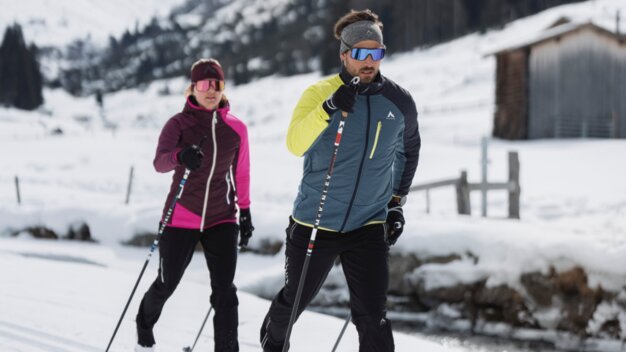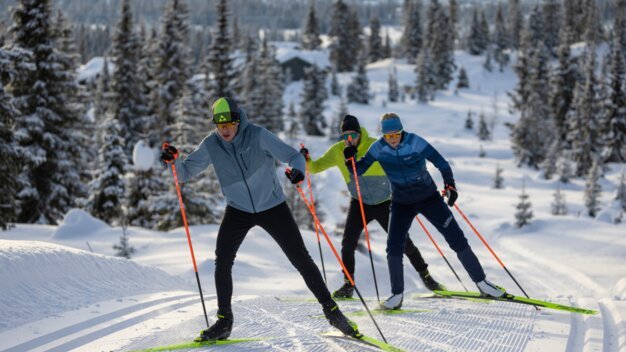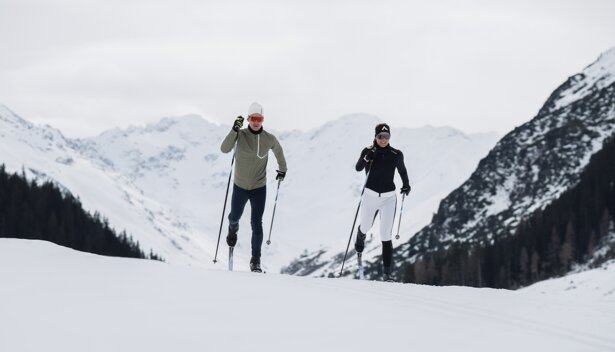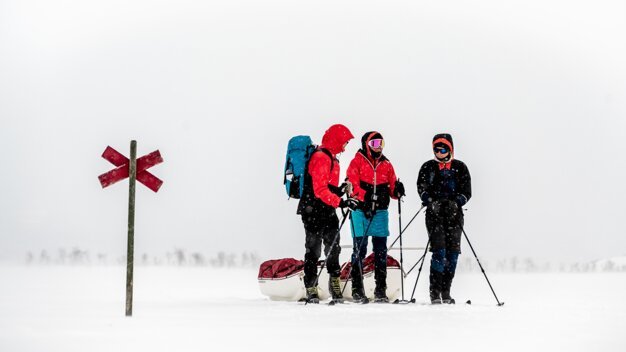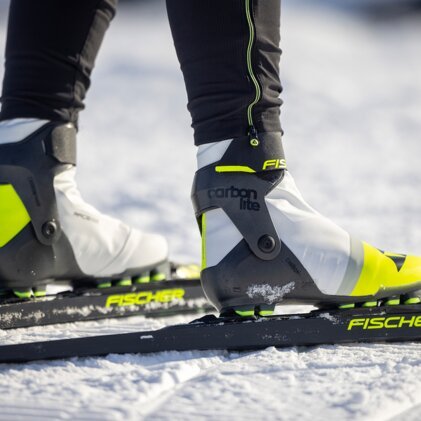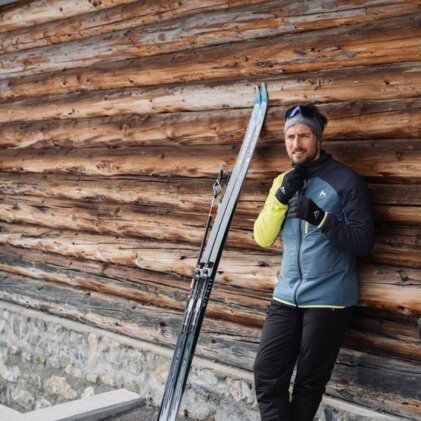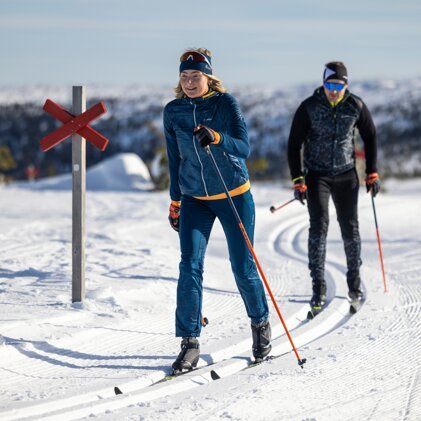
The requirements for cross-country ski boots are high: the footwear must not be restrictive, it has to offer stability and should provide optimum power transmission. In order to select the right model for your personal needs, we have answered relevant questions in connection with the purchase of cross-country ski boots.
In the following article, we look at the different types of cross-country skiing boots, the right size, differences between models for men and women and some care instructions. Enjoy reading and have fun on the slopes!
What types of cross-country ski boots are there?
There are two different styles of cross-country skiing:
- classic
- skating
Accordingly, there are also specific boots that offer you support when practising the respective discipline. For those who want to remain flexible, hybrid models are the right choice as they can be used for both styles and beyond.
Suitable boots for classic cross-country skiing
Ski boots for classic cross-country skiing are designed for maximum mobility and comfort during the forward rolling movement, but still offer sufficient support in the heel area. They are relatively light, low-cut and quite flexible.
- For beginners: cross-country skiing boots with a thick lining that provide optimum support for heels and bones
- For professionals: models with a low weight thanks to a thin inner lining; the sole and shell are made of stiff material in the heel area - this improves power transmission
Cross-country ski boots for skating and what they are made of
The ankles are subjected to greater strain when skating than when practising the classic style. For this reason, the shoes have a special design with a higher shaft, stiffer sole and reinforced ankle support. Most shoes for the skate style are also made of a synthetic material mix or lightweight carbon.
Characteristics of hybrid cross-country ski boots
For all those who want to practise both styles of cross-country skiing without having to own a separate pair, there are combination boots. To provide the necessary power for the skating style, the models have either a higher shaft or a shaft brace. The latter is removable and can be flexibly adjusted to provide stability when skating without restricting freedom of movement when classic cross-country skiing. In terms of the hardness of the sole, combi boots are in the medium range.
What defines a backcountry cross-country ski boot?
As the name suggests, these models were designed for adventures off the groomed trails. They look more like hiking boots than ski boots and are characterised by a high, often padded shaft. Integrated gaiters ensure that snow cannot penetrate from the outside, while an additional layer of insulation prevents temperature loss. They also have a coarse, firm sole and can only be combined with backcountry bindings (NNN, BC or 75 mm).
What makes a cross-country boot for roller skis?
Cross-country skiing in summer? That is also possible. Boots for roller skis are primarily characterised by particularly breathable materials. They come without additional layers of insulation, which is why they are lighter. As with conventional cross-country ski boots, a distinction is made between models for skating and classic cross-country skiing. Most roller ski boots are also compatible with standard cross-country binding systems.
How to find the right size for your cross-country ski boots
The right size of your cross-country ski boot plays an important role in terms of performance and comfort. Optimum power transmission is only guaranteed with the right model. The basic rule is: choose cross-country ski boots half a size or a whole size larger than your running or road shoes! This allows you to put on thicker socks without getting painful pressure points.
However, the right size is also a question of the intended use. Models for the classic style and combination models require more room in the toe box than skating shoes. This free space should be at least 5 millimetres - this is the only way to achieve an optimal foot rolling movement. The shoe must neither constrict nor pinch.
Boot-fitting techniques such as thermoforming are often used to ensure that the cross-country ski boot fits like a second skin: the boot model is moulded to your foot with millimetre precision.
What are the sizes of cross-country ski boots from different manufacturers?
The following information on the sizes of the respective boot brands will help you choose the right model:
- Cross-country ski boots from Fischer tend to run small and are only available in whole sizes. It is therefore best to always add 1-1.5 sizes.
- The Rossignol sizes correspond to the Mondopoint size, i.e. the foot length in cm. If you are wavering between two sizes, the larger size is usually the better choice.
- The sizes of Salomon cross-country ski boots usually correspond to those of normal street shoes. If you are in between sizes, you should ideally opt for the larger version.
- Madshus brand models are usually slightly smaller, but some also correspond to the normal size.
Finding the right binding for your cross-country ski boots
In addition to the optimal size for your cross-country ski boots, the right binding system is also crucial. When buying, make sure that your boots and bindings are compatible with each other. Each model has its advantages and disadvantages. The following variants are available:
- NNN (New Nordic Norm) - based on two narrow centre bars
- SNS (Salomon Nordic System) - based on a single centre bar; not compatible with NNN bindings, available in different versions for classic and skate skiing
- Prolink - a system developed by Atomic and Salomon, which is compatible with all NNN and Turnamic variants.
- Turnamic - a binding developed by Fischer and Rossignol based on the NNN system; tool-free adjustability and easy handling
It's worth taking a look at the different models to start with. If you don't really know yet where your own journey on cross-country skis will take you, you will appreciate the flexibility of a binding system such as NNN, Prolink or Turnami. If you already have a clear idea of what you want, other specialised variants may also be of interest to you. In our article on cross-country ski bindings, we looked at the advantages and disadvantages of the individual models. If you are still unsure about your choice, our RENTertainers will be happy to help you with professional advice in one of our shops.
Which socks are best to wear with cross-country ski boots?
Cross-country ski socks serve as a connection between your feet and the boot and are an important part of your overall cross-country ski clothing. The models differ in terms of material, thickness, length, finish (seams) and padding. We have summarised some tips for you:
- When it comes to material, you should opt for synthetic fabrics such as polyester or natural fibres like merino wool. These textiles absorb moisture quickly and release it to the outside. With merino wool, you also have the advantage of active warmth.
- The right sock thickness depends on the weather and how cold you feel. You can choose thicker socks for cold days or deep snow, while thinner versions are suitable for warmer temperatures. However, bear in mind that cross-country skiing boots are often tight-fitting, so the socks should not be too thick to avoid pressure points.
- You determine the length of the socks according to your preferences. However, make sure that they are longer than the shaft of your cross-country ski boots. This will prevent unpleasant pressure points.
- You should make sure that the seams are flat and do not cause friction. The safest option: completely seamless sock models.
Tips from our RENTertainers:
- If possible, buy cross-country skiing boots and socks at the same time - so you can try them on together! If you already have matching socks, you can also take them to the shop and make sure they work together perfectly.
- On icy cold days, you can also wear another pair of socks. However, it is important that your shoes have enough room for the extra layer.
- Taking spare socks with you is particularly useful for longer stays on the trail. If the pair you are wearing gets wet, you can swap them for the other ones. This will keep your feet warm and dry.
The right cross-country skiing outfit
The tried and tested onion principle with three layers is also recommended for cross-country skiing:
- Base layer: A close-fitting, moisture-regulating base layer (preferably made from synthetic fibres or merino wool)
- Mid layer: A warming layer of clothing that retains body temperature (e.g. long-sleeved shirt or light puffer jacket)
- Hard shell: Outer layer that protects against wind and moisture (lightweight, breathable jackets and trousers with ventilation openings).
It is important that your clothing is breathable, lightweight, and flexible because you are constantly moving and sweating when you cross-country ski. Complete your outfit with matching accessories such as gloves, a hat or headband and sunglasses. For maximum comfort, you can a opt for a small belt bag or a drinking belt.
How do I care for my cross-country ski boots?
Do you want to extend the lifespan of your cross-country ski boots? With the right care, you can make an important contribution to this. We'll show you how:
- Cleaning after each session: Remove any snow residue from your cross-country ski boots after every session! A brush or soft cloth is ideal for removing dirt and moisture. This will preserve the function of the fasteners and hinges.
- Allow to dry: Give your shoes enough time to dry after a cross-country skiing session! Remove the insoles - if this is possible - and leave them to dry separately. Please do not use heaters or ovens to dry your shoes, as the intense heat could damage the materials.
- Clean the inner lining: Most cross-country ski boots have a removable inner lining. A wash cycle and subsequent drying will ensure that it stays fresh. Make sure that the inner lining is completely dry before the next use.
- Check the fastenings: Check the fasteners of your cross-country ski boots regularly to make sure they are working properly! If the fasteners are defective, you can have them replaced.
- Waterproofing: Some cross-country ski boots have water-repellent coatings that can wear off over time. You can renew the waterproofing by using special sprays and other products: Simply follow the manufacturer's instructions!
- Storage: Keep your cross-country ski boots in a cool, dry place - preferably in a ventilated room! Closed or damp containers are unsuitable, as this can cause mould to form.
Why are insoles useful for cross-country ski boots?
If you have insoles for your road or running shoes, it may make sense to use them for cross-country skiing too. They often correct misalignments and prevent possible injuries.
Selected suppliers manufacture customised insoles. Although the purchase is somewhat more expensive, experienced cross-country skiing experts agree that it pays off. After all, a perfect fit results in a better athletic feel and optimised power transmission.
A blessing for cold-sensitive people: heatable insoles! In addition to a better fit, your feet are pleasantly warm at all times.
What fasteners are available for cross-country ski boots?
Boots for cross-country skiing are equipped with different types of fasteners to ensure a secure and comfortable fit. The most common types include
- Lacing: The majority of cross-country skiing shoes have lacing, similar to conventional sports shoes. This can consist of traditional laces or quick fasteners that make it easier to put on and take off.
- Velcro fasteners: Selected models can be closed with Velcro fasteners, which are placed over the instep or ankle. This type of fastening is particularly easy to adjust and simple to adapt.
- Zips: Versions with zips impress with their quick and easy fastening options. They can either run over the instep or along the ankle.
- Buckle systems: Some racing and performance cross-country shoes use systems similar to those used on ski boots. This ensures a very tight and secure fit. However, this closure mechanism is less common and is mainly favoured by experienced cross-country skiers.
If you have now acquired a taste for cross-country skiing and are planning to try it for the first time, you can also benefit from our cross-country skiing equipment rental. Our RENTertainers in our more than 800 locations will help you choose the right skis and give you useful tips for your first steps.
Frequently asked questions about cross-country ski boots
Are there cross-country ski boots for wide feet?
Many brands also offer cross-country ski boots specifically for wide feet. It's best to try on models from different manufacturers! We know that Rossignol or Salomon models are usually wider than Fischer models.
Is it better if cross-country skiing boots are narrower or wider?
In general, cross-country skiing boots should fit rather snugly to ensure ideal power transmission. However, too tight is not conducive, as this increases the risk of pressure points. In this case, it is also important to wear a suitable pair of socks made of moisture-regulating materials such as polyester or merino wool.
Does every cross-country boot fit every binding?
No, not all systems are compatible with each other. We have put together an overview of which boot fits which binding:
| Binding system | Compatible shoe soles |
|---|---|
| NNN | NNN, Prolink, Turnamic |
| Prolink | NNN, Prolink, Turnamic |
| Turnamic | NNN, Prolink, Turnamic |
| SNS | Only compatible with SNS models |
INTERSPORT Rent tip
The RENTertainer recommends
Which cross-country ski boots you ultimately decide on depends on your personal preferences and your specific needs and your cross-country skiing style. When buying, also pay attention to a user-friendly fastening: leisure cross-country ski boots and beginner models often have laces or Velcro fasteners. Performance-orientated models and racing boots, on the other hand, have more advanced fastening systems such as buckles. If you need help choosing your boots, our RENTertainers look forward to seeing you at one of our locations. Have fun out there!
Related articles
You may also be interested in:
